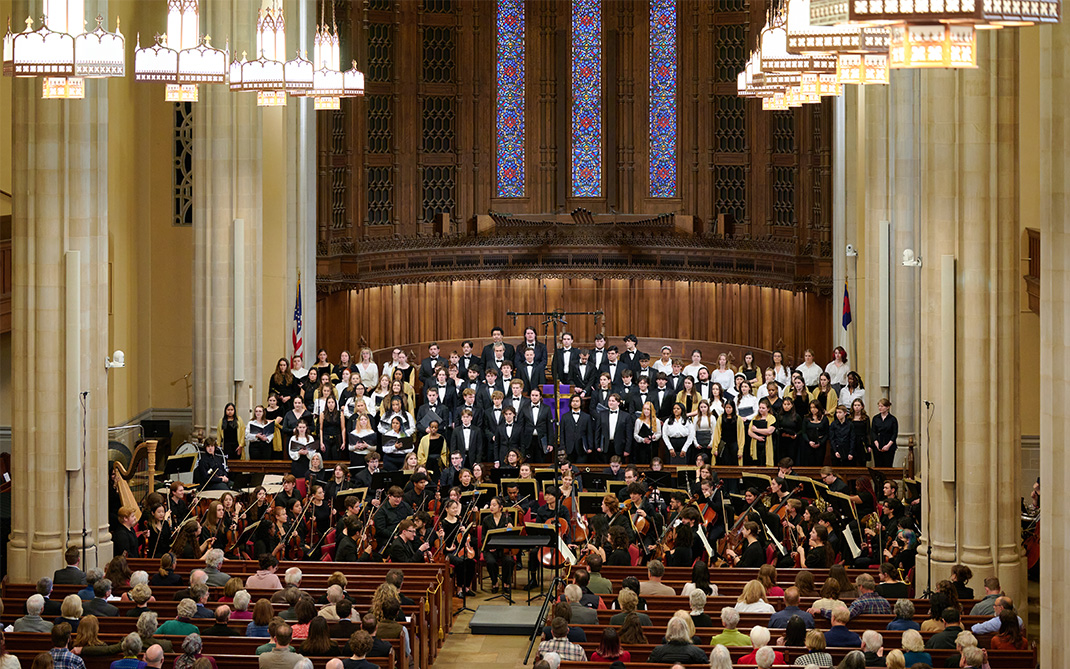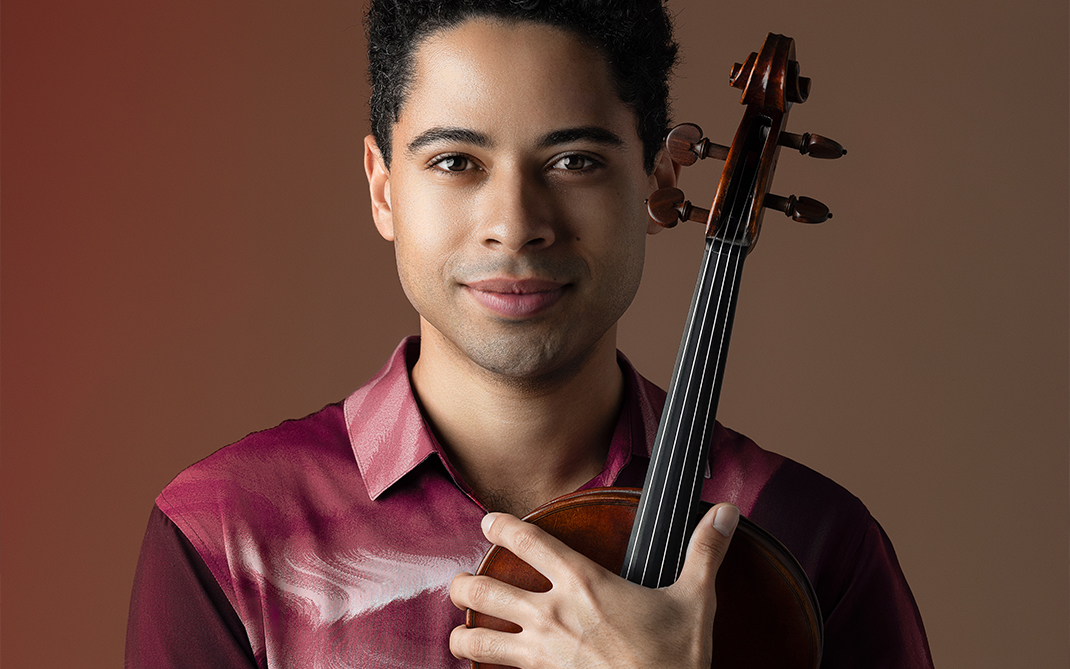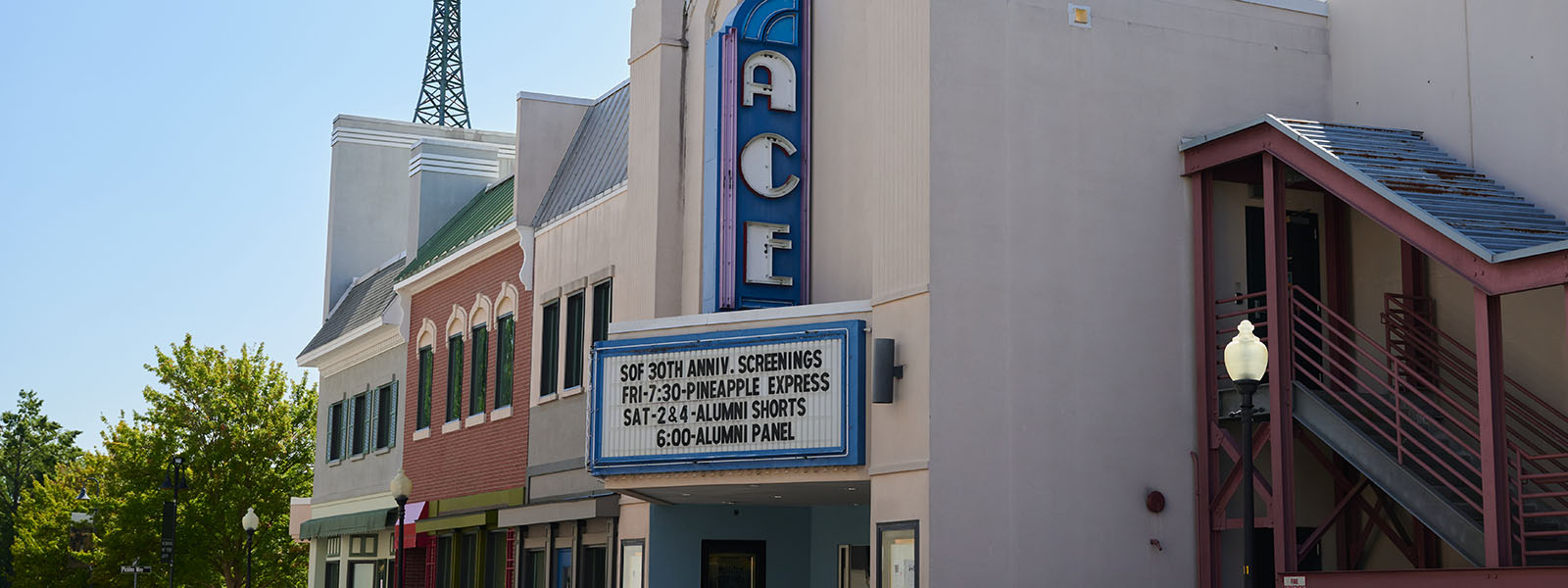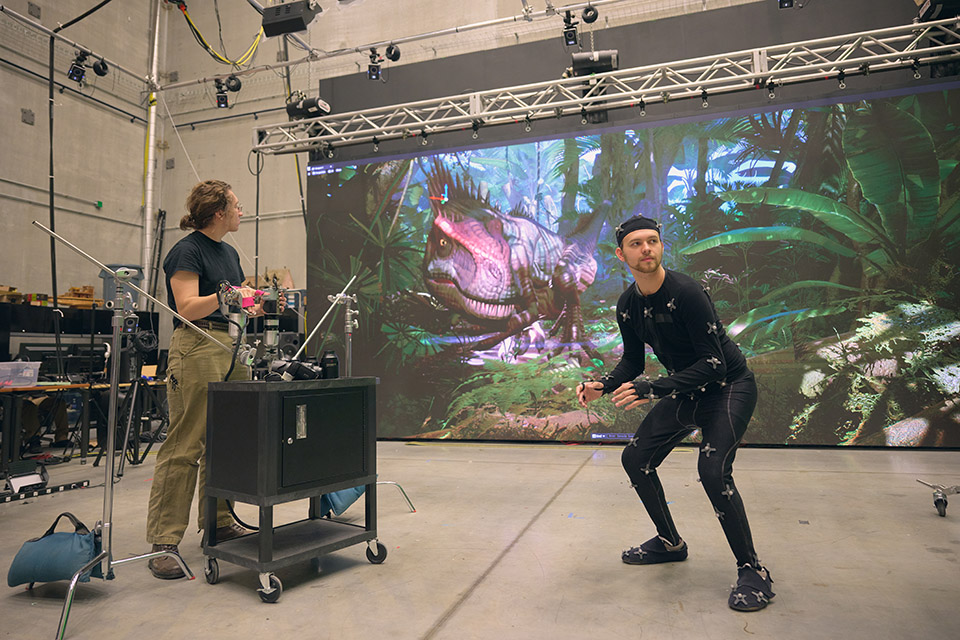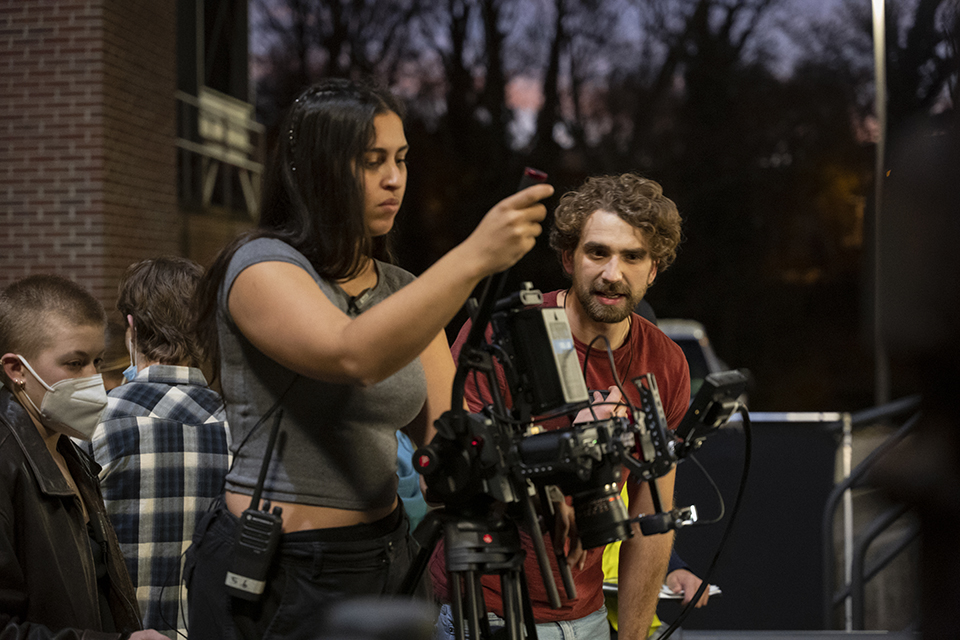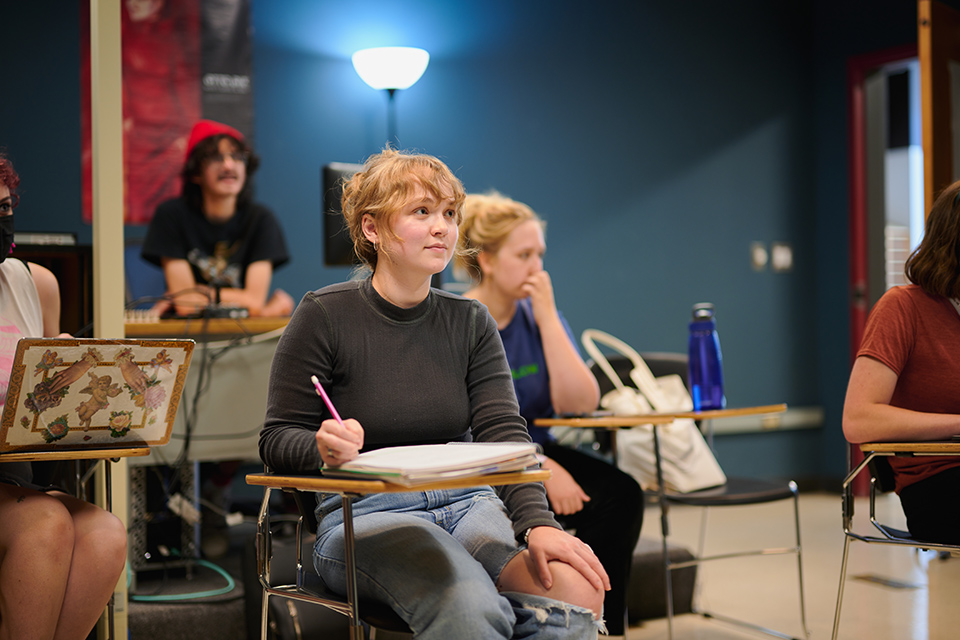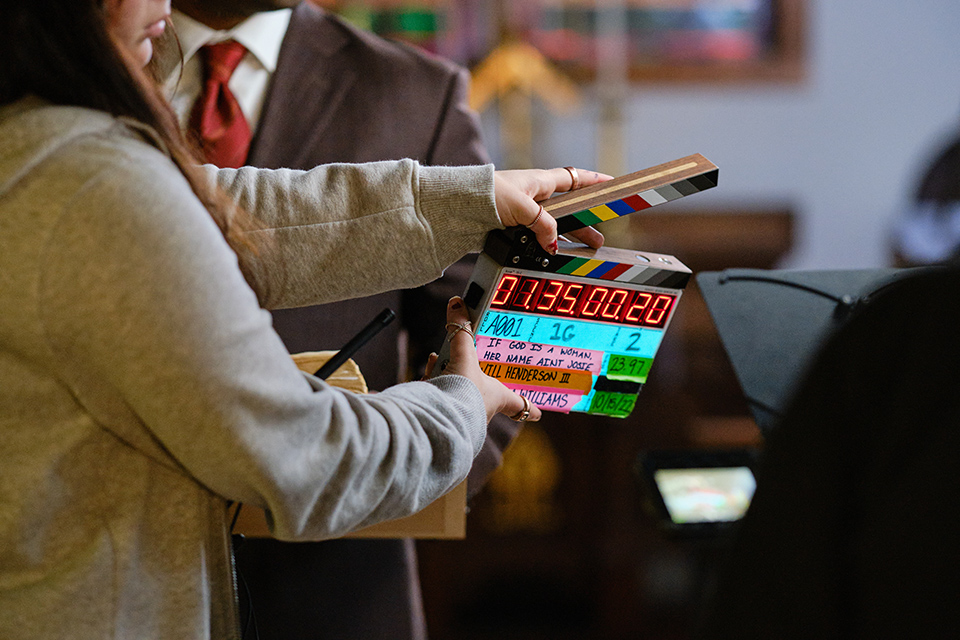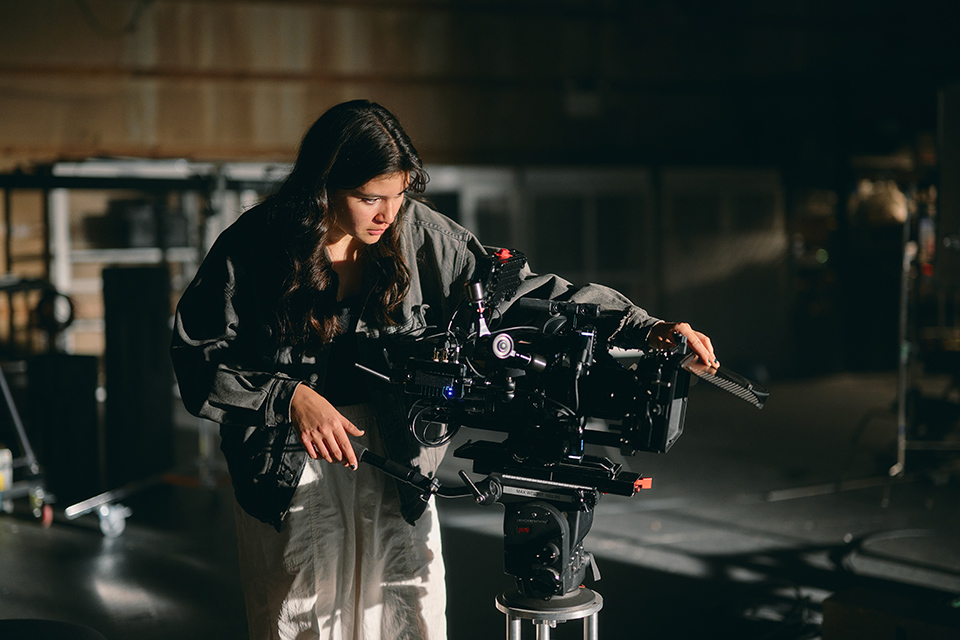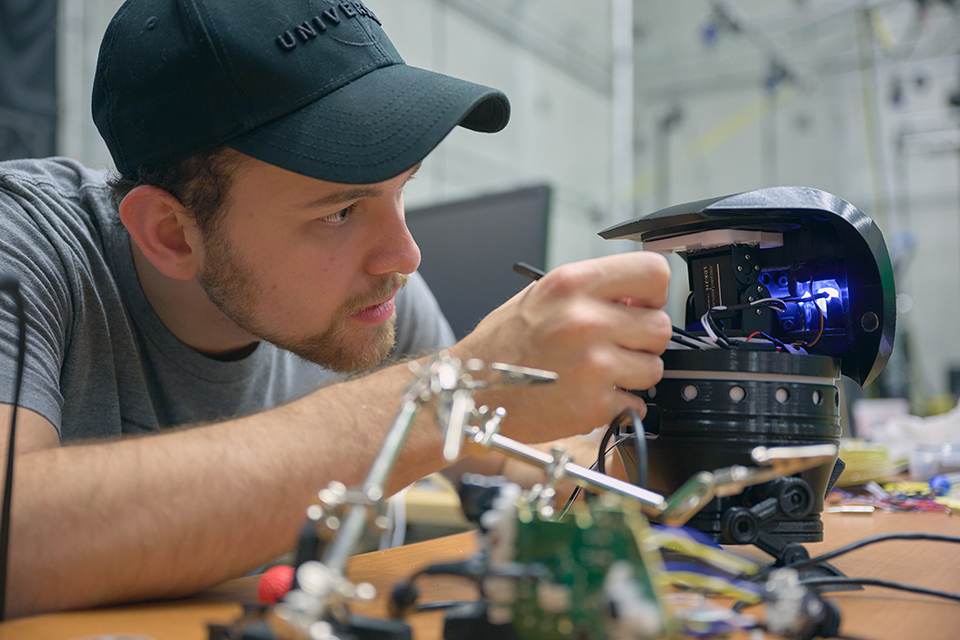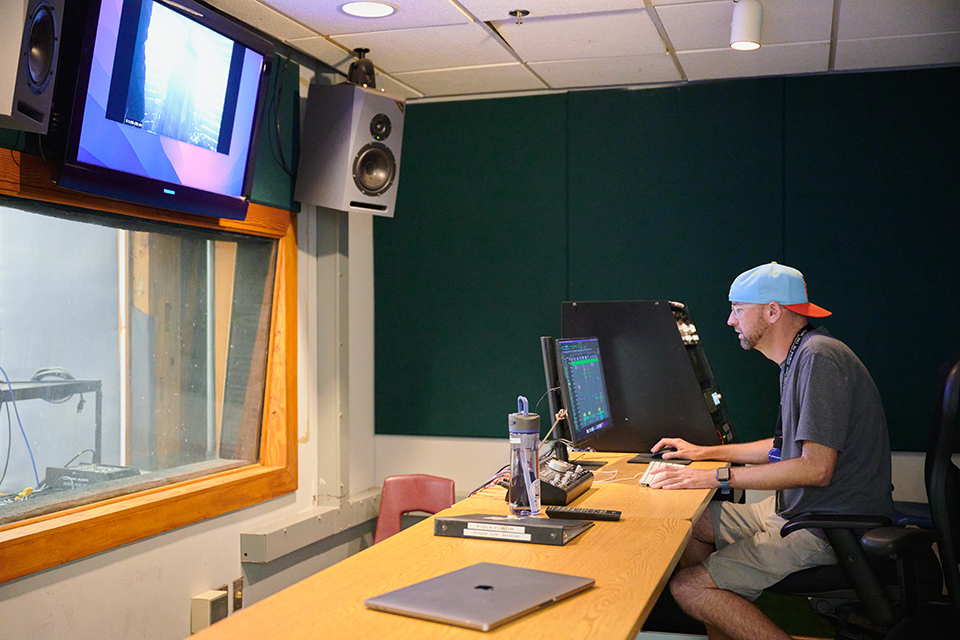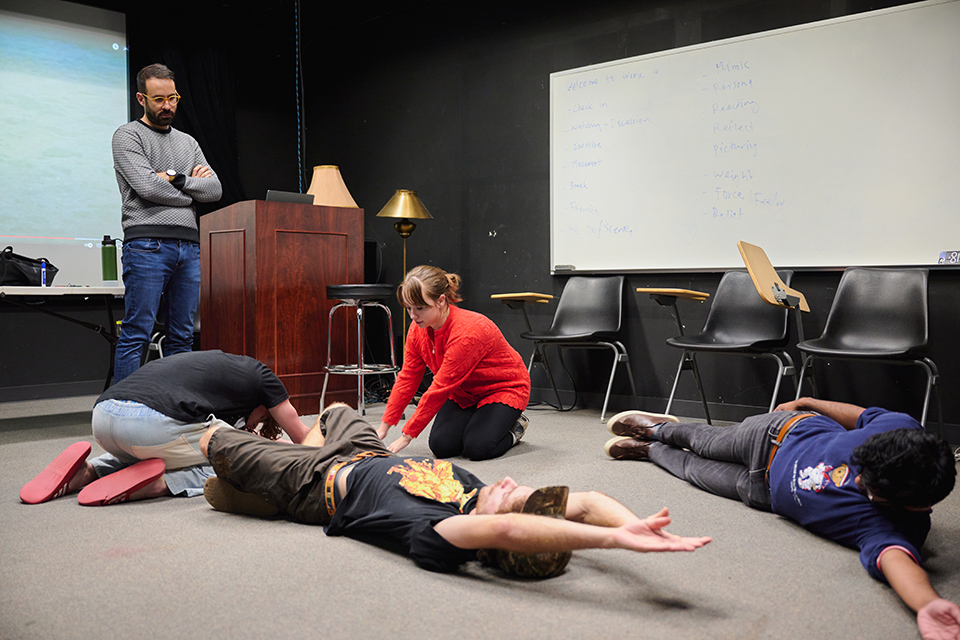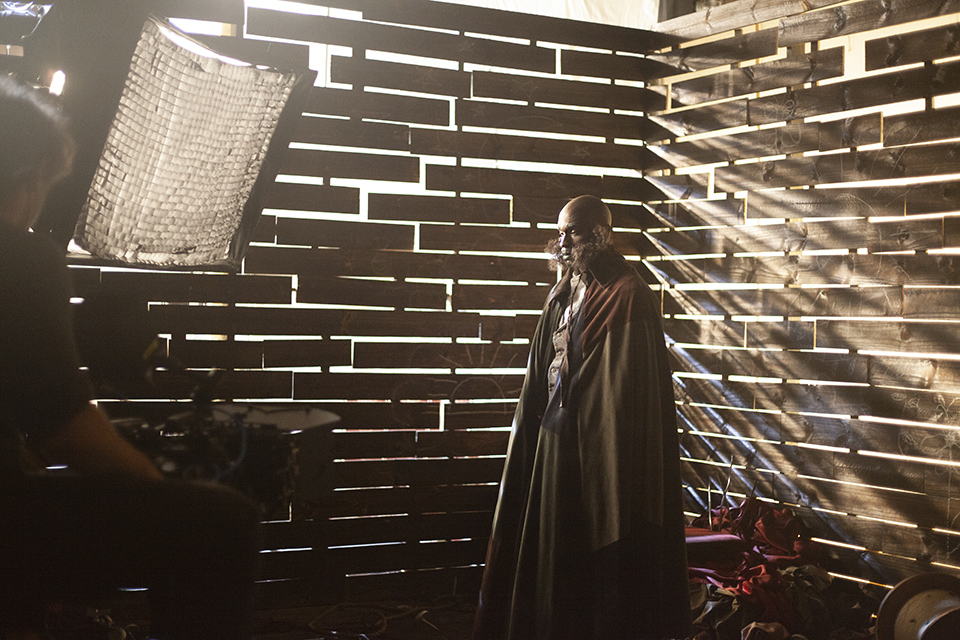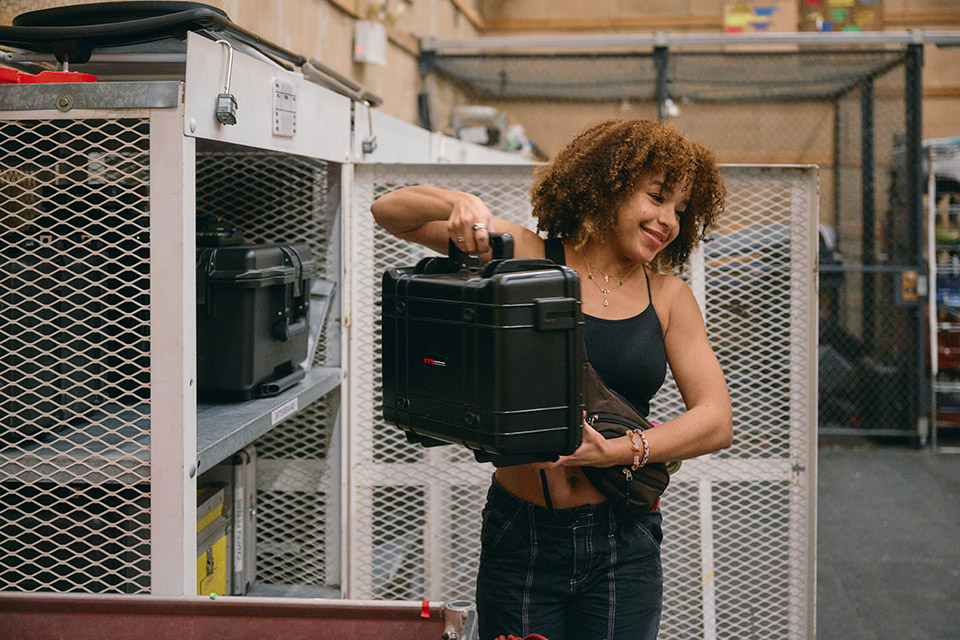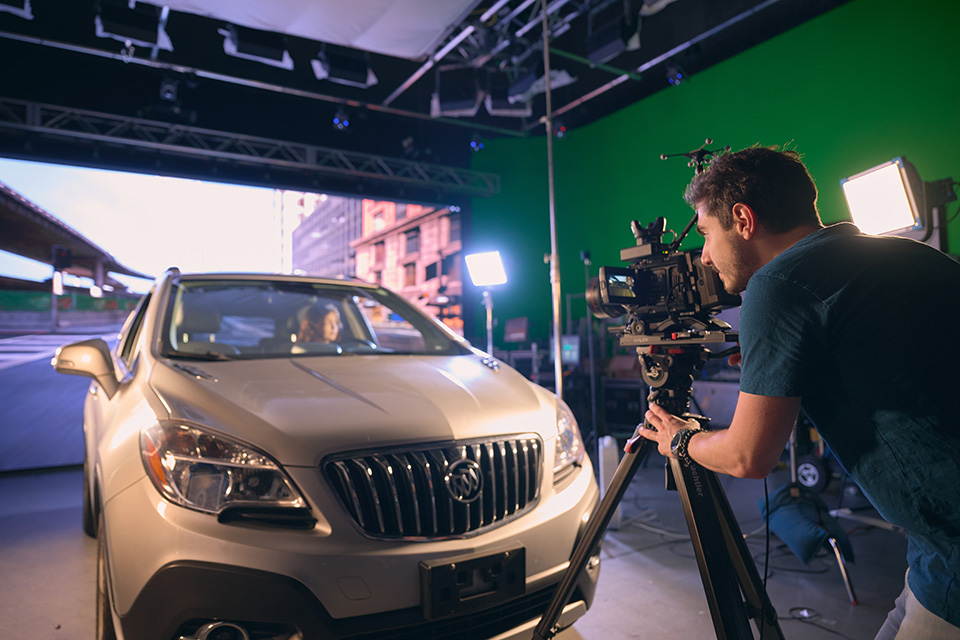At 30 years, UNCSA School of Filmmaking embraces a new wave of storytelling
It’s a warm, sunny day in Winston-Salem. One might expect a college campus to be buzzing with movement and noise as students take advantage of the beautiful autumn weather. But a turn from Giannini Drive to Hollywood Boulevard is met with stillness — a quiet street with no students in sight, except for a few scurrying to class in ACE Exhibition Complex. But we know better.
Behind closed doors, Film Village is exploding with sound and motion. Film reels are threaded, the foley stage springs into action, someone tosses a roll of gaffer tape to a crew member, lights dim in an editing suite, notes are furiously scribbled on a script, screens flicker to life, a storyboard is carefully displayed…
For students, alumni, faculty and staff of the UNCSA School of Filmmaking, it’s a familiar scene. The school has evolved over the last thirty years, building on a rich tradition of cinematic storytelling while expanding with new and innovative pursuits. It has been an intentional growth, shepherded by strategic leadership and passionate faculty members.
“I think it’s critical for any film school who wants to remain dynamic and relevant to constantly be evaluating itself and asking where it fits into the larger picture of the industry and culture as a whole,” says Dean Deborah LaVine, who has led the school since 2021. “We aren’t considering how to adopt new trends. We are staying ahead of them.”
Indeed, the School of Filmmaking has been ahead of the curve since its inception.
The wonder years
When Chancellor Emeritus Alex. C Ewing assumed his role at UNCSA in 1990, he envisioned a film school that would complement the established conservatories. He has said the idea wasn’t new or revolutionary; it had been tossed around for years. But there was a newfound drive to execute it. With support from UNCSA (then NCSA) founder John Ehle and film producer Borden Mace, the School of Filmmaking received a green light from the Board of Governors of the University of North Carolina in 1992. Sam Grogg, former president and chief operating officer of Apogee Productions and Magic Picture Inc., was tapped to be the first dean.
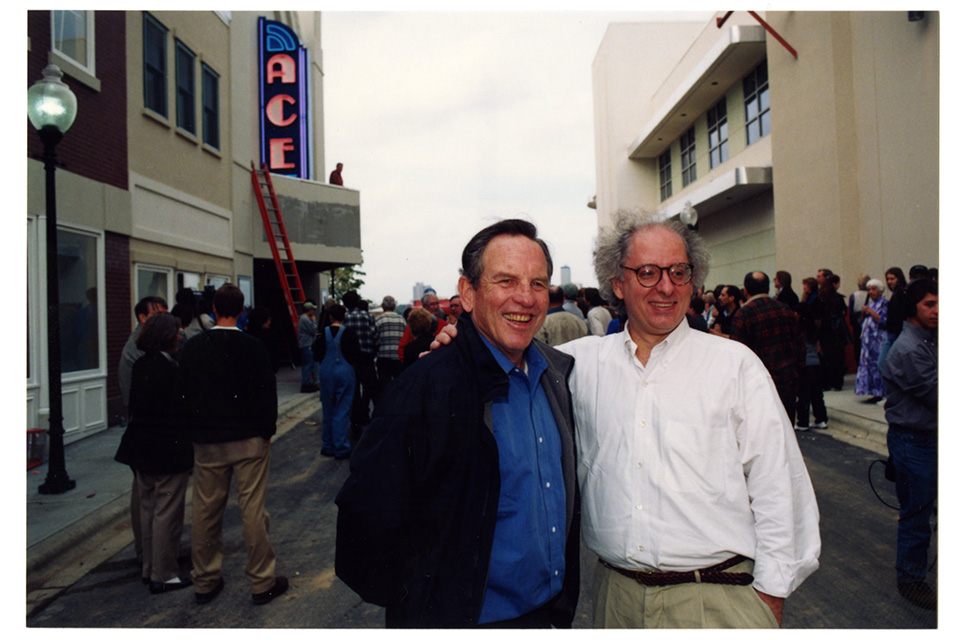
Former Chancellor Alex C. Ewing (left) and School of Filmmaking founding Dean Sam Grogg (right) at the ACE Theatre Dedication, Oct. 25, 1997 / Photo courtesy of the UNCSA Archives
Fifty-eight new undergraduate film students arrived in the fall of 1993, taught by five faculty members. There were seven concentrations to study, the same as today: animation, cinematography, directing, picture editing & sound design, producing, production design & visual effects and screenwriting. The school was scrappy and made a home in a former diaper factory, where they built a small screening room, and in a former transmission garage, which was converted into a soundstage. But Grogg understood the need for additional facilities so that students could train in environments similar to the larger film industry. UNCSA broke ground on Film Village in 1995 and the new buildings were dedicated three years later.
“If you’re going to train doctors, you need a hospital,” reasons Grogg. “It was the same for us. If you’re going to train filmmakers, you need the real thing. And we always believed we weren’t training students… we were training filmmakers.”
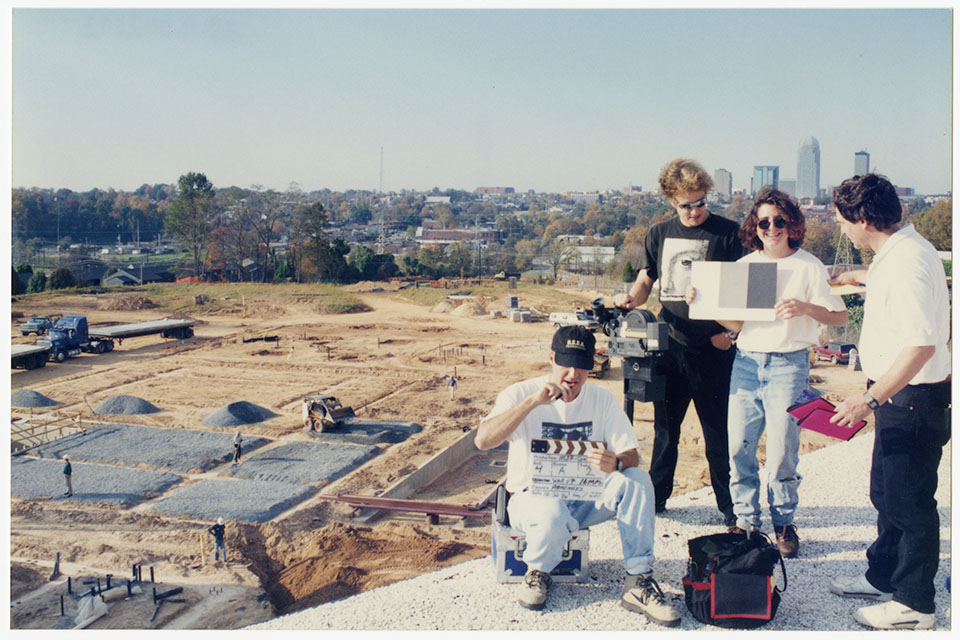
Faculty member Arledge Armenaki right, and film students document beginning construction of the ACE Theatre Complex, Oct. 30, 1996 / Photo courtesy of the UNCSA Archives
In the early years, student filmmakers developed a distinct brand of storytelling — one that differentiates UNCSA from other major film schools, and one that continues today. Grogg describes it as stories rooted in personal experience.
“You can tell the various schools [when you watch student films],” says Grogg. “And many of them really rely on popular culture: the film of the moment or the style of the moment. They’re trying to look like what they think should be a calling card into the industry. But I’m telling you, the best calling card is a good story that is well told.”
Professor Emeritus Dale Pollock, who followed Grogg as the second dean of the Film School in 1999, agrees and expands on the personal storytelling approach: “What I found was a southern, North Carolina voice,” recalls Pollock. “We encouraged the students to not walk away from regional stories.” Pollock cites early student films “Door to Door,” “Noble Chrome Pirates” and “Physical Pinball” from filmmakers like Beth Petty (’97), Jeff Nichols (’01) and David Gordon Green (’98) as examples.
Marks of distinction
The hands-on nature of the program is also distinctive. “Our students spend 70% of their time in film classes, compared to 20-40% at other schools” says Pollock. Nearly 200 films are made at UNCSA each year, and students gain on-set experience as early as their first weeks at school.
Student thesis films come with an assigned budget, removing the barrier of fundraising. Throughout the 30 years of the School of Filmmaking, students and alumni have often cited this as a primary reason for attending UNCSA. Without the financial burden of having to fundraise for projects, students are able to focus on their craft. This financial support also makes film school an accessible option for students who otherwise would be unable to afford to pursue their dreams of becoming a filmmaker.
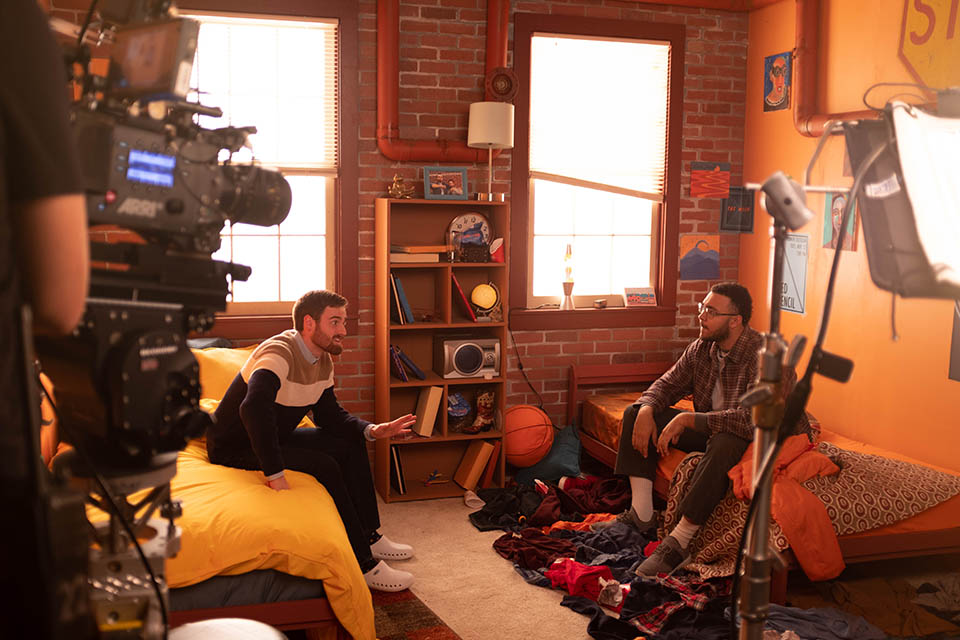
Drama and Filmmaking students on set of Fourth Year thesis film "Sideways," Fall 2019. / Photo: Hailey Cheyenne Port
Alumni like director and screenwriter Nichols cited affordability as one of the main reasons he is a filmmaker today. "Public funding was integral to my being able to afford to go to film school," says Nichols. "Not only did that affect tuition, but the school paid for us to make our films and student films. Had there been an additional cost on top of tuition, I don’t think, financially, my family could have shouldered that."
Though the school’s student body has more than doubled in size since the early years, including the addition of graduate degree programs, there are ample opportunities for close mentorship with faculty members and for spirited collaboration with peers from Dance, Design & Production, Drama and Music.
“We have a fantastic cohort of deans [at UNCSA],” says LaVine. “Everyone really believes in cross-collaboration and wants each school to succeed.” It’s not uncommon for film students to work on personal projects with their peers, but deans have also searched for ways to bring students together under UNCSA’s robust performance calendar. This year, Holiday Suite is being offered for the second time. The immersive holiday experience is an all-school collaboration set in Film Village and is full of sensorial experiences crafted by both students and faculty.
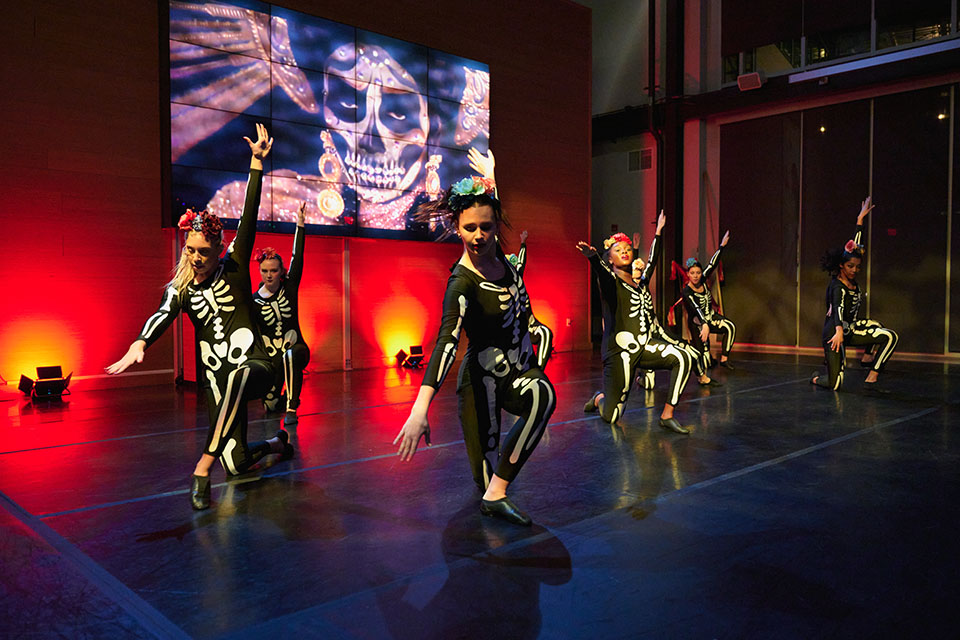
Students and faculty from the Schools of Dance and Filmmaking collaborate for the first ever Holiday Suite performance in Dec. 2023 featuring holidays such as Dia de los Muertos / Photo: Wayne Reich
And the collaboration extends beyond campus through student exchange programs in both Germany and Latvia. “The film industry is an international business,” says LaVine, “so students should have the opportunity to learn about international works.”
New tools for storytelling
In addition to emphasizing collaboration, faculty and staff are constantly asking questions to help refine and expand both curriculum and programming. What do students need to develop their skills? What will provide them with sustainable and satisfying careers? How do we surprise ourselves? “I ask insiders what they look for from recent graduates,” says LaVine. “Consistently, they will say people who know how to generate ideas and people who are adaptable. As a school, we need to nurture that.”
“There are evergreen fundamentals we want to teach… the basics of narrative storytelling,” she continues. “But we also want to provide the space to break the rules of narrative storytelling so students can think outside the box.”
Thinking outside the box of traditional filmmaking includes embracing new tools and new forms of storytelling. LaVine points to the recently-formed Story Art Studio as a way students are being encouraged to work outside the traditions of formulaic storytelling. The two-year pilot program includes cross-disciplinary elective classes within the School of Filmmaking, where students can create in a “sandbox” environment with various tools at their disposal. Sample projects from the program might look like a film that combines inanimate objects with live action or an immersive, virtual space to explore. And the industry has noticed these efforts. The Hollywood Reporter cites Story Art Studio in its latest film school ranking, for which UNCSA ranked eighth (and first for public universities) — its highest ranking in the publication to date.
“A big change in our school is the approach to what is the right way or the wrong way of making films,” explains LaVine. “There’s no wrong way when it comes to creative ideation.” Trends in the industry have fractured over time, paving the way for a new approach and a new generation of filmmakers.
Pollock recognizes the need to redefine a film conservatory for the 21st century. He describes today’s filmmakers as content creators. And content can be anything. “Branding work, commercials, feature films, streaming series… there’s a million definitions of content,” he says. “Why limit yourself by calling yourself a filmmaker? That’s a huge shift.”
LaVine adds immersive experiences to the list. “What the industry faces now is an epidemic in people watching screens,” she explains. “There’s a hunger in the audience space for other kinds of experiences.”
The Media + Emerging Technology Lab (METL) at UNCSA has grown over the last seven years from a supporting program to a community-centric immersive storytelling incubator. “It’s an all-encompassing artform,” says LaVine, and one that provides space for both students and faculty to discover possibilities outside of traditional cinema. “The Tree I Carry,” presented in 2023, was conceived by faculty member Shahin Gorgani and featured spaces fitted with imagery, sounds and scents that captured the essence of Iran, Gorgani’s home country.
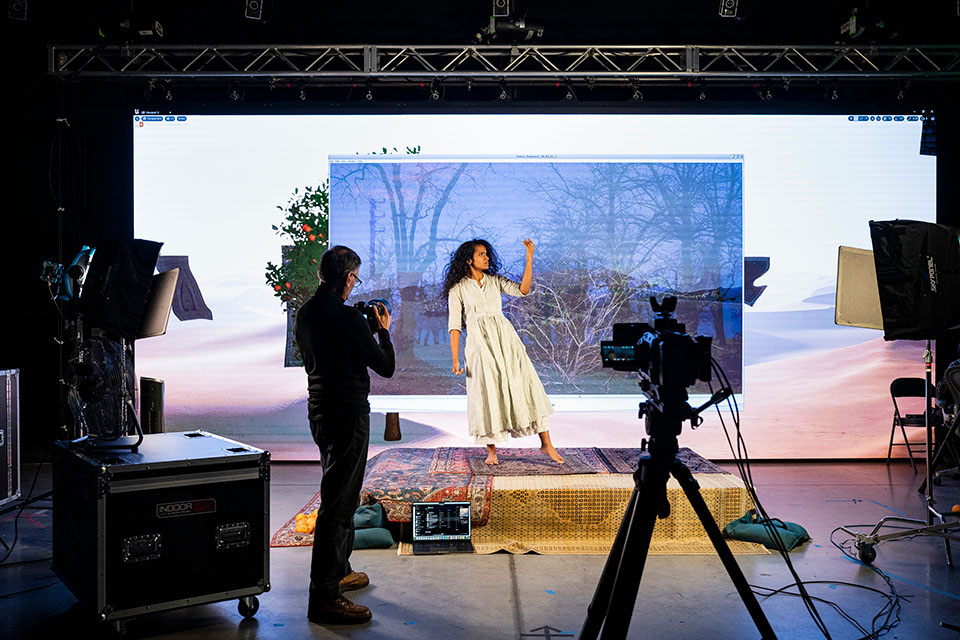
Filming and photography of "The Tree I Carry" at the Cube, the main facility for the Media and Emerging Technology Lab (METL) / Photo: Allison Lee Isley
In 2024, an experimental installation was accompanied by the documentary film “We Are, Because We Were,” which was accepted to the International Black Theatre Festival Film Fest. Through the documentary, a production team of UNCSA and Wake Forest University filmmakers explored the Winston-Salem African American Archive and its mission to preserve the history of the Black community in Winston-Salem.
An evergreen education
With many advances propelling the School of Filmmaking forward, there are still familiar cornerstones of the student experience. Guest artists continue to be a hallmark of the curriculum, allowing for fresh perspectives, industry knowledge and firsthand experiences to be shared with students. The school’s new Symposium series opens the guest artist experience to the public, inviting alumni and other industry guests and artists to speak on campus weekly.
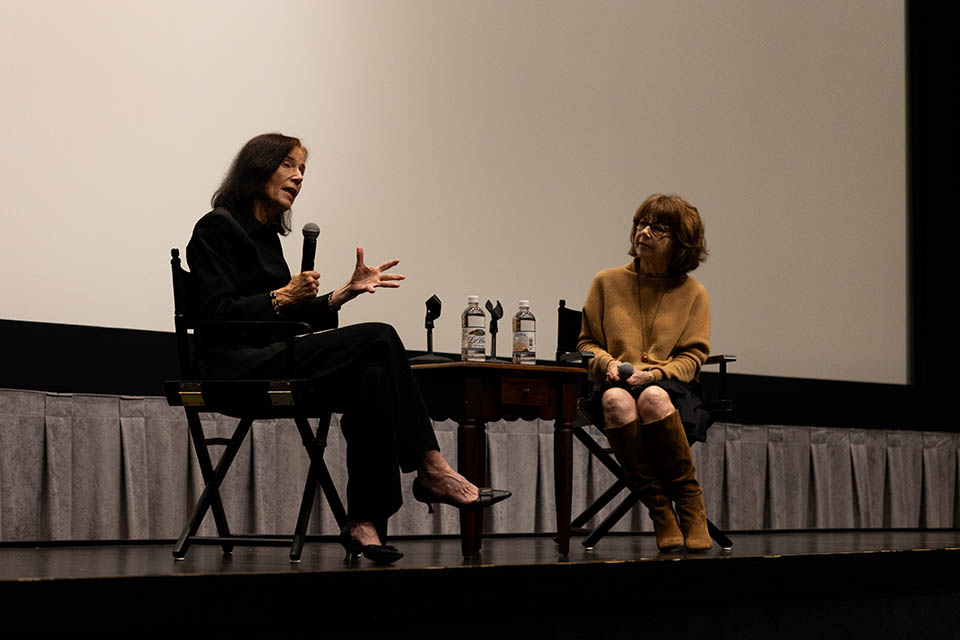
Legendary Disney screenwriter Linda Woolverton (left) in coversation with Dean LaVine (right) / Photo: Shelby Lail
The annual Los Angeles trip for graduating students has broadened to match changes in the industry. Thesis films are no longer screened on the trip. Instead, they’re available digitally for a limited time to a much wider audience. An alumni panel event allows students to make direct connections with other Fighting Pickles. In addition to studio tours at locations like Paramount and Warner Brothers, graduates might also have the opportunity to meet with an indie producer who works out of their garage. An equivalent trip to New York City is now offered (revived from the early 2000’s) as well; both trips responding to the needs and interests of the young filmmakers.
And, as always, alumni are continuing a tradition of excellence in creative storytelling with recent credits in popular series, documentaries, films and more — like MAX’s “The Penguin” and Netflix’s “Will & Harper.” Some alumni, like unit production manager and producer Gilana Lobel (‘05), have used their talents close to home. Lobel has led planning for the School of Filmmaking’s legacy celebration in honor of the 30th anniversary.
“Our students are well trained and they understand their responsibilities [upon graduation],” says Pollock. “They know they have to be prepared.” And through an intentional balance of evergreen and future-focused work, they will be. “We are a big school with big ambitions,” LaVine adds. “We can ride the constant wave of industry change… and we can teach from that.”
When asked what she most desires for students and alumni, LaVine has a simple hope: “I want them to achieve their dreams! I want to have given them the tools, confidence and skills to make themselves happy and content.”
Get the best news, performance and alumni stories from UNCSA.
SUBSCRIBE TO OUR NEWSLETTERS(OPENS IN NEW TAB)
October 17, 2024
